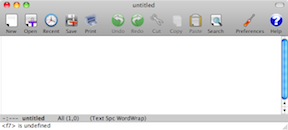Aquamacs is a port of the Emacs editor to
the Apple Macintosh windowing environment. One of the
main advantages of Aquamacs over traditional emacs is
that, in addition to standard keyboard input, it also
supports the graphical user interface elements such
as moving the insertion point with the mouse, and
having menu bars to aid user in accessing editor
functionality. Thus, one does not need to remember
special emacs key sequences to successfully
edit files.

The first installation step is to download
the installer from the
Aquamacs home page. The installer is a disk
image file with a .dmg suffix. Double-clicking
on the file (e.g., Aquamacs-Emacs-2.1.dmg) should
open a Finder window similar to the figure on right.
To complete installation, you need to drag the Aquamacs
icon over the hand and onto the Applications icon in the
installer window. This will install Aquamacs into the system
applications folder (i.e., /Applications). You may be
prompted for the password to the administrative account for
your computer if your account does not have sufficient
privilieges. In the latter case, you also have the option of
dragging the Aquamacs icon to any other Finder location
(e.g., in you home folder) to install it elsewhere.

To run Aquamacs, just double-click on its icon, wherever
it may be installed. That should bring up a window that looks
like the figure on right. You can open files using the Open
button on the toolbar. When you open Python source files, Aquamacs
will color-code the file contents, e.g., make keywords purple and
function names blue. To edit the file, simply point-and-click to
move the insertion point; typing enters the input into the file;
hitting backspace erases the characters before the insertion
point. There is obviously much more functionality, so experiment
with the program. In particular, click the Python -> Describe
mode menu item to get a description of keyboard shortcuts to
run Python code, start a Python interpreter window, etc.

